An Editor’s Guide to Writing and Publishing Science

Michael Hochberg
Oxford University Press, £27.50
Writing for peer-reviewed publications is an integral part of the job for many biologists, and communicating clearly and concisely the outcomes of research is important. However, all too often papers are rejected for poor writing as much as for the quality of the reported research. The nuanced style and coded structure of scientific writing is a complex craft and it can take a long apprenticeship to learn, typically in parallel with the pathway from postgraduate student to independent investigator. In this context the author presents an invaluable compendium of insider’s tips and pitfalls to avoid in preparing a paper to submit to a journal.
As editor-in-chief of Ecology Letters for a decade, Hochberg has read thousands of manuscripts so is in a position of authority to discuss how and how not to write scientific research for peer-reviewed publication. This readily accessible text covers all the steps, from selecting an appropriate journal to dealing with the revision and resubmission process.
The stages of manuscript writing are dissected, providing detailed advice on completing each standard paper section. The peer-review process is demystified, including how referees are selected and common reasons for rejection. Strategies for rebutting a reviewer’s critical appraisal and what to do if your paper is rejected are perceptive and emboldening. The emerging challenges of archiving and sharing data, article-processing charges and the influence of citation metrics are each considered.
This book is highly recommended to postgraduate students, postdoctoral researchers and early career academics.
Prof Andrew Taylor-Robinson CBiol FRSB


